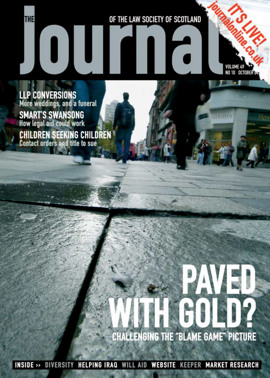The race is on (again)
For those who did not rush to read the House of Lords decision in Burnett’s Trustee v Grainger following the letters in the June and August editions, consider this. Your client purchases a flat, pays the purchase price and take possession. The disposition transferring ownership is registered eight months later (we will not go into the reasons for the delay). However, proceedings are raised by the seller’s trustee in sequestration seeking a declarator that property in the flat was vested in him and had been since the date of sequestration because the seller executed a trust deed for creditors at some point after the sale but before the disposition was recorded. Is your client the owner of the flat?
The sheriff at first instance found for the trustee. On appeal the sheriff principal decided to await the decision of the House of Lords in Sharp v Thomson (reported as Sharp v Woolwich Building Society 1997 SC (HL) 66), and then followed it. The issue in that case turned on whether the Thomsons’ flat formed part of the “property then subject to the charge” (Insolvency Act 1986, section 53(7)) when a floating charge granted by the builder from whom they purchased the flat, crystallised 11 days before the disposition in their favour was registered. The Court of Session, at first instance and on appeal, applied the ordinary principles of property law in Scotland and held that ownership had not passed to the Thomsons. The fact that the disposition had been delivered but remained unregistered was irrelevant.The House of Lords however held that as the beneficial interest had passed to the Thomsons, the flat was not property subject to the charge when it crystallised.
The House expressed the opinion that it was unfair to leave the Thomsons with nothing except a possible claim against their solicitors. They used the (English) legal concept of “beneficial interest” as a solution to the problem, implying a recognition that more than one right of ownership can exist simultaneously. The House concluded that the seller, having delivered the disposition and accepted payment, no longer had any beneficial interest in the property. Until the disposition was registered, it remained owner in the technical sense but with only bare title. Beneficial interest was with the Thomsons. On this analysis it is apparent that “property” was lost with beneficial interest and accordingly the flat was not caught by the floating charge.
Relying on this decision, the sheriff principal in Burnett’s Trustee allowed the Graingers’ appeal. That decision was reversed by the Inner House. The Graingers appealed to the House of Lords who unanimously refused the appeal. The question which the court addressed was whether the flat fell within section 31(1) of the Bankruptcy (Scotland) Act 1985, which provides that, subject to certain exceptions, “the whole estate of the debtor shall vest as at the date of sequestration in the permanent trustee for the benefit of the creditors”. They distinguished the large body of case law in relation to the phrase “whole estate” from the relatively recent statutory concept of “property” subject to a floating charge. In their view, the crucial issue was who obtained the real right in the property. Here, the trustee was first to register and therefore obtained the real right. The House of Lords therefore confirmed that where a seller is sequestrated before the purchaser has registered the disposition in their favour, there is a race to register between the purchaser and the trustee in sequestration.Neither the Inner House nor the House of Lords were prepared to follow Sharp v Thomson. Lengthy decisions were given by both Lord Hope and Lord Rodger, and the English Law Lords were not prepared to disagree. Lord Bingham expressed no view but Lord Hoffmann made it plain he thought the decision unfair and unnecessary. Lord Hobhouse noted that section 33 of the 1985 Act expressly provided that property held on trust by the bankrupt did not vest in the trustee, and thought there was made out a prima facie case of bare trust which would have avoided the injustice of the case. This was not an argument accepted by Lords Hope and Rodger, the latter pointing out there was no declaration of trust or anything else to suggest the seller intended to act as trustee. But what if she had done so? In Lord Hope’s words “This problem could have been cured by inserting words into the disposition which had this effect”.
Sharp v Thomson was distinguished in Burnett’s Trustee but not overruled, thereby restricting Sharp v Thomson to receivership. Sequestration and receivership have been dealt with. Will we have to litigate to resolve the same issue in relation to liquidation and administration, or will we need to litigate a trust clause as discussed in recent contributions to the letters page of this Journal?
Alistair Burrow, Tods Murray LLP
In this issue
- Citizenship, society and solicitors
- The well unfair state
- Litigation nation
- Best medicine
- Take a deep breath
- What title?
- Walk this way?
- Know your strategy
- e-quilibrium?
- The researchers
- Rights out of anarchy
- Political correctness or positive change?
- Steering clear
- How far can a board go?
- Major role for new tribunal
- The race is on (again)
- Planning a superhighway
- Website reviews
- Book reviews
- Single survey's lonely heart
- In harmony
- Clearing the path






